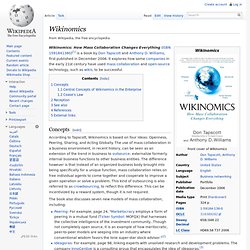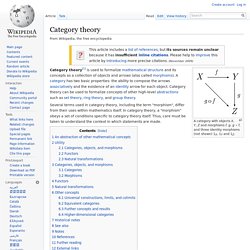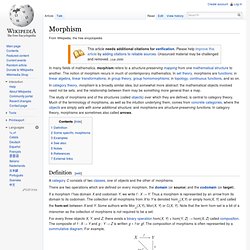

Wikinomics: How Mass Collaboration Changes Everything. Concepts[edit] According to Tapscott, Wikinomics is based on four ideas: Openness, Peering, Sharing, and Acting Globally.

The use of mass collaboration in a business environment, in recent history, can be seen as an extension of the trend in business to outsource: externalize formerly internal business functions to other business entities. The difference however is that instead of an organized business body brought into being specifically for a unique function, mass collaboration relies on free individual agents to come together and cooperate to improve a given operation or solve a problem. This kind of outsourcing is also referred to as crowdsourcing, to reflect this difference. This can be incentivized by a reward system, though it is not required. The book also discusses seven new models of mass collaboration, including: The last chapter is written by viewers, and was opened for editing on February 5, 2007.
Central Concepts of Wikinomics in the Enterprise[edit] Coase's Law[edit] Videos.
Category theory. A category with objects X, Y, Z and morphisms f, g, g ∘ f, and three identity morphisms (not shown) 1X, 1Y and 1Z.

Several terms used in category theory, including the term "morphism", differ from their uses within mathematics itself. In category theory, a "morphism" obeys a set of conditions specific to category theory itself. Thus, care must be taken to understand the context in which statements are made. Morphism. In category theory, morphism is a broadly similar idea, but somewhat more abstract: the mathematical objects involved need not be sets, and the relationship between them may be something more general than a map.

The study of morphisms and of the structures (called objects) over which they are defined, is central to category theory. Much of the terminology of morphisms, as well as the intuition underlying them, comes from concrete categories, where the objects are simply sets with some additional structure, and morphisms are structure-preserving functions. In category theory, morphisms are sometimes also called arrows. Definition[edit] There are two operations which are defined on every morphism, the domain (or source) and the codomain (or target). If a morphism f has domain X and codomain Y, we write f : X → Y. For every three objects X, Y, and Z, there exists a binary operation hom(X, Y) × hom(Y, Z) → hom(X, Z) called composition. Morphisms satisfy two axioms: Some specific morphisms[edit]